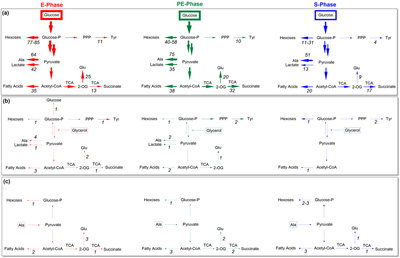Metabolic plasticity of Francisella tularensis subsp. holarctica (wild type), Francisella novicida and Francisella sp. strain W12-1067
Authors: Thomas Steiner, Fan Chen, Kerstin Rydzewski, Clara Morguet, Felicia Achatz, Wolfgang Eisenreich and Klaus Heuner
Ger. J. Microbiol.
2022.
vol. 2, Iss. 1
pp:19-29
Doi: https://doi.org/10.51585/gjm.2022.1.0012

Abstract:
Francisella tularensis is a Gram-negative bacterium that causes a potentially fatal disease called tularemia. The highly infectious agent can spread via arthropod vectors, including ticks, and via rodents such as rabbits or beavers. The facultative intracellular pathogen typically invades human macrophages at the onset of human infection. For intracellular replication of the bacteria, the usage of amino acids from the host cells and gluconeogenesis seem to be detrimental, but other carbon sources including glucose and glycerol are also utilized. Here, we compared the growth phase-dependent degradation of glucose, glycerol, and alanine in F. tularensis subsp. holarctica isolated from an infected beaver with the respective metabolism in the less virulent strains F. novicida strain U112 and Francisella sp. strain W12-1067. To this aim, we performed 13C-labeling experiments with the bacteria growing in medium T supplemented with either [U-13C6]glucose, [U-13C3]glycerol, or [2,3-13C2]alanine during different growth phases. After cell harvest, mechanical disruption, and hydrolysis of cellular fractions, we determined the 13C-profiles in various metabolites by mass spectrometry. The detected 13C-patterns elucidated the metabolic fate of the supplied carbon nutrients and revealed minor, but significant differences indicative of various metabolic phenotypes of the Francisella strains under study. Glucose served as the main substrate for all strains under the experimental conditions. The sugar was degraded via the Embden-Meyerhof-Parnas pathway as the major catabolic route during growth. At lower rates, exogenous glycerol and alanine were used as co-substrates, particularly in the less pathogenic strains during the later growth phases. Our data support the hypothesis that, among other factors, the capability to adapt substrate usages efficiently and metabolic fluxes could determine the virulence of Francisella strains.
Keywords:
Francisella, Intracellular bacteria, 13C-Labeling, Isotopologue profiling, Metabolic adaptation, Tularemia
Statistics:
Article Views: 2131
PDF Download: 59